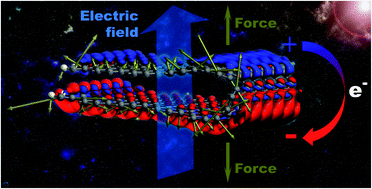The closed-edge structure of graphite and the effect of electrostatic charging†
Abstract
The properties of graphite, and of few-layer graphene, can be strongly influenced by the edge structure of the graphene planes, but there is still much that we do not understand about the geometry and stability of these edges. We present an experimental and theoretical study of the closed edges of graphite crystals, and of the effect of an electric field on their structure. High-resolution transmission electron microscopy is used to image the edge structure of fresh graphite and of graphite that has been exposed to an electric field, which experiences a separation of the graphene layers. Computer simulations based on density functional theory are used to rationalise and quantify the preference for the formation of multiple concentric loops at the edges. A model is also presented to explain how the application of an electric field leads to the separation of the folded edges.



 Please wait while we load your content...
Please wait while we load your content...